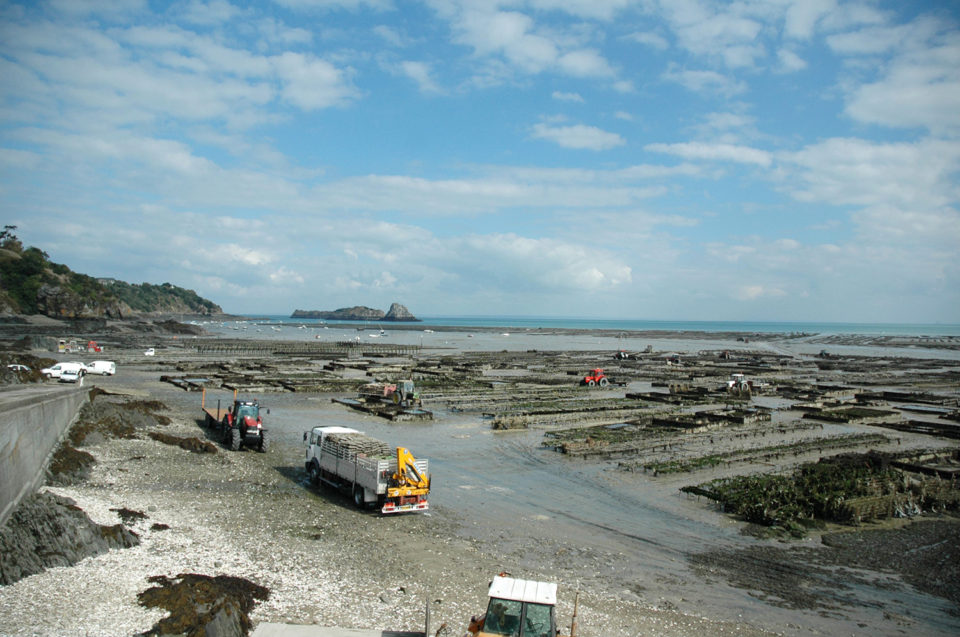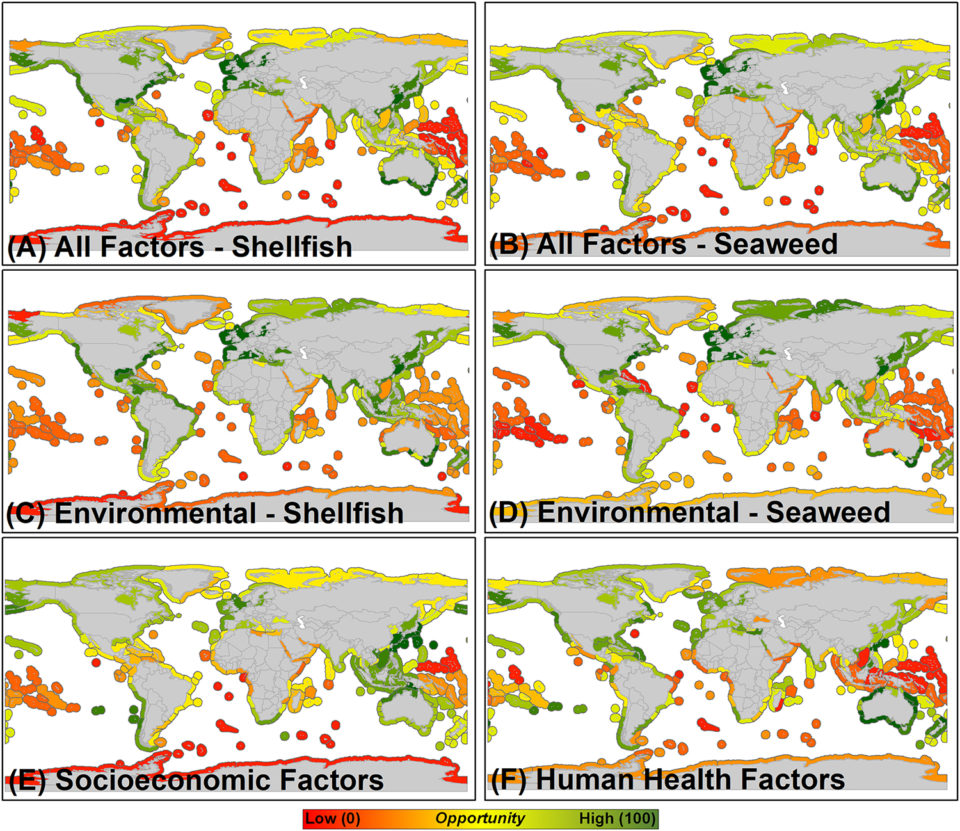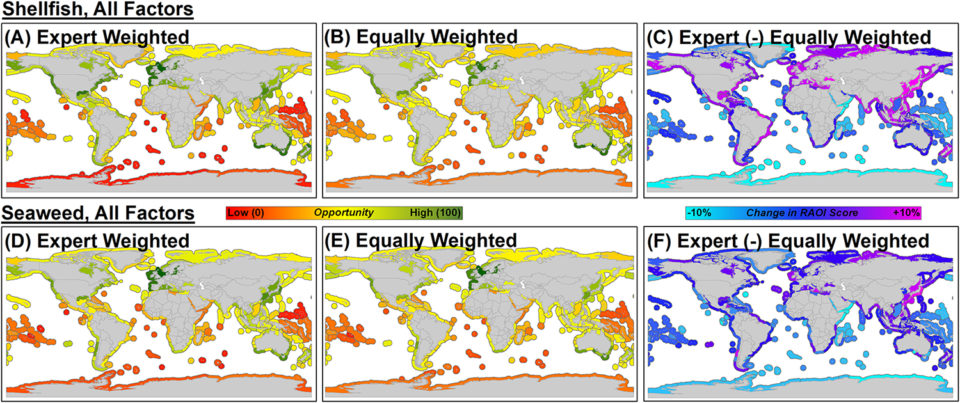Spatial analysis shows where marine aquaculture can benefit nature and people

When managed within a broader ecosystem framework and strategy, aquaculture has the potential to enhance ecosystems and provide increased benefits to humanity, with values potentially returned through a wide range of regulating, provisioning, habitat, and cultural ecosystem services.
Aquaculture includes a diversity of activities and objectives, including ‘industrial’-scale food production, specialized operations focused on environmental outcomes or multi-species production for broader benefits, and native species restoration. By actively designing aquaculture to deliver ecosystem services, it may be possible to achieve greater positive impact on ecological, economic and social needs through enhanced habitat restoration, increased employment and increased food security, respectively.
This article – adapted and summarized from the original publication – reports on a study that conducted a global-scale spatial analysis incorporating a broad suite of global datasets representing key environmental, socioeconomic and human health considerations. The study developed a novel, quantitative global index – the Restorative Aquaculture Opportunity Index, or RAOI – to aid in identification of marine ecoregions with substantial opportunity to benefit from ecosystem services provided by development of restorative shellfish and seaweed aquaculture (hereafter referred to as High Opportunity Marine Ecoregions, or HOMEs.
Study setup
The study conducted an initial literature review to understand the broad set of environmental, socioeconomic and human health dimensions that might define where development of shellfish and seaweed aquaculture could mitigate environmental challenges and ensure societal benefits while accounting for constraints to sustainable development.
Then, an expert panel of stakeholders was convened to identify model inputs to the RAOI and weight their relative importance. A geographic information system (GIS)-based modeling approach was then used to integrate spatial data layers representing 16 environmental, socioeconomic, and human health factors to calculate the RAOI under varying scenarios optimized for shellfish and seaweed aquaculture, and to assess the sensitivity of the RAOI to the expert weightings and to individual factors.
For detailed information on the identification of applicable factors; expert stakeholder input to guide determination of factors and their weightings; assembly, processing and standardization of spatial data; model calculations; and sensitivity analysis, refer to the original publication.
Results and discussion
The current global distribution of shellfish and seaweed aquaculture operations, the magnitude of global production, and the annual global growth rate of the overall aquaculture sector suggest that there is a significant opportunity for policy and other interventions to shift the sector’s trajectory towards one that maximizes ecosystem and social benefits. Our study helped better understand where the ecosystem recovery and societal benefits are most likely to be realized through shellfish and seaweed aquaculture development.
High opportunity marine ecoregions (HOMEs) distributed throughout Europe, North and South America, Asia and Oceania were identified as having the highest Restorative Aquaculture Opportunity Index (RAOI) scores within the scenarios that incorporated all environmental, socioeconomic, and human health factors – indicating the substantial opportunity across the globe for shellfish and seaweed aquaculture to provide environmental and socioeconomic benefits.

Within identified HOMEs, the environmental opportunity is generally greatest (i.e., potential to mitigate nutrient pollution, trawl fishing pressure, ocean acidification risk, habitat loss;), socioeconomic conditions are generally sufficient (i.e., history of aquaculture production, regulatory quality, logistics performance) and human health concerns are generally minimized (e.g., sufficient wastewater treatment).
As RAOI scores represent a composite across environmental, socioeconomic, and human health factors, no single marine ecoregion (ME) received an RAOI score of 100 indicative of the counterbalance of opportunity and risk associated with shellfish and seaweed aquaculture development. Notably, HOMEs tended to be adjacent to upper-middle or high-income nations; these results do not preclude the importance of sustainable aquaculture development within MEs adjacent to low or lower-middle income nations.
Of the top 25 HOMEs for shellfish aquaculture, nine were located in Oceania (53 percent of all MEs in Oceania), eight in North America (24 percent), five in Europe (28 percent) and three in Asia (7 percent). For seaweed aquaculture, the top 25 HOMEs included six located in Europe (33 percent of all MEs), six in Asia (14 percent), six in Oceania (35 percent), five in North America (15 percent) and two in South America (8 percent).
Correspondingly, significant industry developments are underway within the countries adjacent to these MEs. Given the scale at which shellfish and seaweed aquaculture operations exist within some of these MEs (e.g., China is the world’s largest aquaculture producer of shellfish), even minor steps towards these suggested ecosystem-oriented improvements are likely to yield substantial benefits.
Moderate opportunity MEs were located throughout South America, Asia and Africa, driven largely by modest environmental and socioeconomic opportunity, and some degree of human health concerns. In some cases, the RAOI scores of MEs with identified elevated environmental opportunity scores were reduced by diminished socioeconomic opportunity scores. Lower opportunity MEs were focused in Southeast Asia, Africa and the Middle East, and the lower RAOI scores associated with these MEs were driven by a combination of reduced environmental and/or socioeconomic opportunity paired with human health concerns.

Development of shellfish and seaweed aquaculture within MEs with high RAOI scores does not guarantee provision of ecosystem services or that ecosystem function will be recovered. While our study provides valuable insight at the global scale to guide strategic aquaculture development initiatives at the scale of MEs, ultimately, multiple factors at successive geographic and ecosystem scales will affect the extent of ecosystem delivery of aquaculture and whether farms ultimately improve or degrade ecosystem function. These factors include the functional traits of culture species, abiotic and biotic characteristics of the surrounding environment, farm design and farming practices.
The pre-existing extent of ecosystem degradation in a given location can make developing commercial shellfish and seaweed aquaculture for ecosystem recovery purposes more or less appealing (e.g. degraded species or areas can be subject to protective regulation). However, these areas can also provide critical opportunities to accelerate ecosystem recovery efforts through development of sustained aquaculture production to support delivery of ecosystem services, and the results of this study inform identification of regions where these opportunities are most likely to be realized.
Appropriately located through use of regional and local scale spatial planning and management approaches, shellfish and seaweed aquaculture development can play a complementary role to aide governments and communities in achieving conservation, ecosystem recovery or other environmental goals.
Through this global-scale spatial analysis, we identified HOMEs for development of shellfish and seaweed aquaculture to support ecosystem recovery and benefit society. These locations of high opportunity – depending on specific environmental, socioeconomic and human health conditions – may benefit from targeted efforts to build in-region technical capacity for shellfish and seaweed aquaculture, improve sector governance, and improve environmental and economic performance of aquaculture to yield benefits to coastal ecosystems and communities.
Examples of these targeted efforts include those in Indonesia and Belize where The Nature Conservancy is working with local fishers, government agencies, and NGO partners to build capacity for sustainable seaweed aquaculture sectors. This includes efforts to train fishers to farm seaweed sustainably (i.e., communication of best management practices for seaweed farming through written publications and in-person trainings). Also, monitoring of pilot seaweed farms to examine and quantify potential benefits and impacts of seaweed farming on water quality and local biota. Also included is coordination with government agencies to establish a spatial management framework and permitting pathway for regulating seaweed farming. Finally, collaborations with major seaweed purchasers to establish incentives for suppliers employing sustainable practices.
Perspectives
Results of our study identify a substantial opportunity for strategic sector development, with the highest opportunity marine ecoregions for shellfish aquaculture centered on Oceania, North America, and portions of Asia, and the highest opportunity for seaweed aquaculture distributed throughout Europe, Asia, Oceania and North and South America.
The high opportunity marine ecoregions we identified represent those specific areas where governments, international development organizations, and investors should prioritize new efforts to drive changes in public policy, capacity-building, and business planning to realize the ecosystem and societal benefits of shellfish and seaweed aquaculture.
Now that you've finished reading the article ...
… we hope you’ll consider supporting our mission to document the evolution of the global aquaculture industry and share our vast network of contributors’ expansive knowledge every week.
By becoming a Global Seafood Alliance member, you’re ensuring that all of the pre-competitive work we do through member benefits, resources and events can continue. Individual membership costs just $50 a year. GSA individual and corporate members receive complimentary access to a series of GOAL virtual events beginning in April. Join now.
Not a GSA member? Join us.
Authors
-
Seth J. Theuerkauf, Ph.D.
Corresponding author
Global Oceans Team
The Nature Conservancy
Arlington, Virginia USA[103,114,111,46,99,110,116,64,102,117,97,107,114,101,117,101,104,116,46,104,116,101,115]
-
James A. Morris Jr., Ph.D.
National Ocean Service
National Oceanic and Atmospheric Administration
Beaufort, North Carolina USA -
Tiffany J. Waters, M.S.
Global Oceans Team
The Nature Conservancy
Arlington, Virginia USA -
Lisa C. Wickliffe, Ph.D.
CSS, Inc. under contract to National Oceanic and Atmospheric Administration
Beaufort, North Carolina USA -
Heidi K. Alleway, Ph.D.
Department of Primary Industries and Regions
Government of South Australia
Adelaide, Australia; and
University of Adelaide
Adelaide, Australia -
Robert C. Jones, M.S.
Global Oceans Team
The Nature Conservancy
Arlington, Virginia USA
Tagged With
Related Posts

Responsibility
GOAL 2018 presentation: Robert Jones, The Nature Conservancy
From the exciting session, "Thoughts on the Future of Aquaculture" at GOAL, is Robert Jones, global aquaculture lead at The Nature Conservancy.

Aquafeeds
Aquafeed moonshots at the F3 ‘talent show’
At the F3 (fish-free feed) Companies Got Talent event in Burlingame, Calif., last week, alternative (non-marine) aquafeed ingredient companies spoke of decoupling aquaculture from fishmeal and fish oil in their quest for greater sustainability.

Responsibility
Lean and green, what’s not to love about seaweed?
Grown for hundreds of years, seaweed (sugar kelp, specifically) is the fruit of a nascent U.S. aquaculture industry supplying chefs, home cooks and inspiring fresh and frozen food products.

Responsibility
In Delaware Bay, a delicate balancing act for shellfish farms
Oyster producers learn to adapt in a Delaware Bay ecosystem that's critical for endangered shorebirds and highly protected horseshoe crabs.


